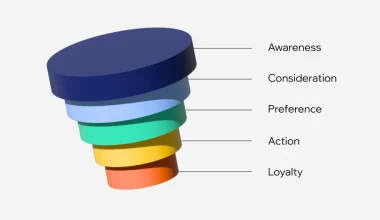Have you heard about performance marketing? Let me explain briefly how I heard it for the first time. So I was having a conversation with a friend who works in digital marketing. We were discussing the latest trends in the industry, and she mentioned that her company used performance marketing to drive sales and measure campaign effectiveness.
They did that by placing targeted ads on social media, partnering with influencers, creating email campaigns, and optimizing their website for search engines. But what made it performance marketing was that they tracked every aspect of their campaigns and adjusted their strategy based on data. In short, they launched targeted campaigns, tracked performance, and optimized for maximum impact. That is how I learned about performance marketing.
Now, do you think this approach is more beneficial than brand marketing, which is a subcategory of branding? Let’s take a closer look at this article to determine that. In this article, we’ll explore the differences between branding ( brand marketing) and performance marketing and examine why they are both effective.
Key Points
- Performance marketing is a measurable approach to digital marketing that focuses on specific actions and trackable results, optimizing campaigns based on data to achieve goals like return on ad spend and cost per conversion.
- Unlike brand marketing, performance marketing uses data-driven methods such as targeted ads, influencer partnerships, and email campaigns to drive immediate results and optimize for maximum impact.
- It relies on measurable KPIs like click-through rates, conversions, and ROI, enabling marketers to directly attribute results to specific campaigns and adjust strategies in real-time.
- Performance marketing’s cost efficiency comes from its pay-for-performance model, where advertisers only pay when a user takes a specified action, ensuring spending is tied to measurable outcomes.
- Integrating performance and brand marketing can enhance results by balancing immediate gains with long-term brand building, aligning strategies to maintain a consistent message, and measuring the impact on both performance and brand metrics.
What Is Performance Marketing?
Performance marketing is a measurable approach to digital marketing, focusing on specific actions (clicks, leads, and sales) and trackable results. It relies on data and analytics to optimize campaigns and achieve goals like return on ad spend and cost per conversion. Unlike brand marketing, performance marketing prioritizes immediate results over emotional connections. It utilizes data-driven mediums like paid search, social media, and connected TV to drive website traffic, generate leads, and increase sales. While highly measurable, performance marketing may overlook building a strong brand identity and audience relationship. It is a data-driven approach, targeting specific actions or conversions through online advertising channels.
Here is a FREE BRAND IMAGE ASSESSMENT template for more aid:
Brand Image Assessment Template.PDF
What Is Brand Marketing?
Brand marketing highlights a brand’s strengths, values, and emotions, focusing on growing awareness and trust. It promotes a feeling of warmth between consumers and the brand through initiatives like billboards, sponsorships, and product placements. Brand marketing establishes a long-term, positive image in customers’ minds by building a strong brand identity, and a unique personality, and resonating with the target audience. It cultivates brand awareness, loyalty, trust, and emotional connection through consistent messaging and visual elements.
Brand marketing is a long-term strategy that differentiates businesses from competitors, establishes industry leadership, and increases credibility and trust. Unlike performance marketing, brand marketing focuses on intangible metrics like brand awareness and customer loyalty, making it challenging to determine effectiveness.
Why Is Performance Marketing So Effective?
The following are reasons why performance marketing is so effective. They include:
#1. Measurable ROI
Performance marketing relies on measurable KPIs like click-through rates, conversions, and ROI. This allows marketers to directly attribute results to specific campaigns, making it easier to optimize and improve future marketing efforts. For instance, a company like Amazon running a pay-per-click (PPC) campaign can track the exact number of conversions generated from each ad group, allowing them to identify top-performing ads and allocate budget accordingly. Amazon can see that a specific ad targeting “summer sales” resulted in 200 conversions, while another ad targeting “back-to-school” resulted in 500 conversions, and adjusted their budget to focus on the higher-performing ad.
#2. Targeted Advertising
Performance marketing leverages data and analytics to identify and target specific audience segments, increasing the likelihood of conversion. This ensures marketing efforts are directed toward those most likely to engage with the brand, optimizing resource use. For example, a fashion brand like Zara can target ads to users who have:
- visited their website in the last 30 days.
- engaged with similar content online (e.g., fashion blogs or influencers).
- demonstrated interest in similar products (e.g., women’s clothing or accessories).
- made a purchase in the last 6 months
Zara can also use lookalike targeting to reach new users who resemble their existing customers, increasing the likelihood of conversion.
#3. Real-Time Adjustments
Performance marketing campaigns can be adjusted in real time based on ad performance and audience responses, allowing marketers to optimize campaigns for better results as they unfold. This agility enables marketers to respond quickly to changes in the market, audience behavior, or campaign performance. For instance, if a social media ad for a new product launch is underperforming, marketers can quickly:
- Pause the ad and adjust the targeting to focus on a different audience segment.
- Change the ad creative to highlight a different feature or benefit.
- Increase or decrease the budget to optimize for better results.
#4. Cost Efficiency
Performance marketing operates on a pay-for-performance model, ensuring cost efficiency. Advertisers only pay when a user takes a specified action, such as clicking an ad or making a purchase. For example, a company like Home Depot can run a pay-per-click (PPC) campaign on Google Ads, only paying when a user clicks on their ad. This approach ensures that marketing spending is directly tied to measurable results.
#5. Data-Driven Decision Making
Data analytics play a crucial role in performance marketing, enabling marketers to make informed decisions. By analyzing data on user behavior, preferences, and trends, marketers can optimize campaigns for better results. For instance, a company like Netflix can analyze viewer data to identify popular genres, actors, or directors and use this information to inform their content marketing strategy.
#6. Multi-Channel Integration
Performance marketing often involves using multiple channels, such as search engines, social media, and email. Integrating these channels creates a holistic approach, ensuring a brand’s presence across various touchpoints. For instance, a company like Walmart can run coordinated campaigns across Google Ads, Facebook Ads, and email marketing, ensuring a consistent message and maximizing reach.
Why Is Brand Marketing So Effective?

The following are reasons why brand marketing is so effective. They include:
#1. Builds Brand Awareness
Brand marketing creates widespread recognition for a brand by consistently presenting its identity, values, and messaging across various channels. This helps consumers become familiar with and remember the brand, making it more likely to be considered when making purchasing decisions. It involves:
- Consistent visual identity (logos, color schemes, typography)
- unique tone and voice in messaging
- Storytelling through advertising and content marketing
- Partnerships and collaborations to expand reach
For example, Coca-Cola’s consistent branding and advertising efforts have made it one of the most recognized brands worldwide.
#2. Trust and Credibility
A strong brand creates a sense of trust and credibility, leading to increased loyalty. Consumers are more likely to choose a brand they recognize and perceive as reliable. For a brand to be trusted, they should be able to provide:
- high-quality products or services
- Transparency in business practices
- Positive customer reviews and testimonials
- Awards and recognition from reputable sources
#3. Emotional Connection
Brand marketing often taps into emotions, creating a connection between the brand and consumers. Emotional connections lead to stronger brand loyalty as consumers feel a personal resonance with the brand. Emotional connection can be built in the following ways:
- Storytelling through advertising and content marketing
- user-generated content campaigns
- Partnerships with influencers or charities
- Emotional messaging in marketing campaigns
Example: Nike’s “Just Do It” campaign evokes emotions and motivates consumers to take action.
Differences Between Brand Marketing and Performance Marketing
| Criteria | Brand marketing | Performance marketing |
| Goals | Brand Awareness: Increase brand recognition. Brand Image: Shape a positive brand perception. Brand Loyalty: Build a loyal customer base. Differentiation: Stand out from competitors. Emotional Connection: Create an emotional bond. Long-Term Growth: Drive long-term growth. Market Positioning: Define the brand’s market position. | Click-Through Rate (CTR): Percentage of users who clicked on an ad after seeing it. Conversion Rate: Percentage of users who completed the desired action out of the total who clicked on the ad.Cost Per Click (CPC): Average cost incurred each time a user clicks on the ad.Cost per acquisition (CPA): average cost incurred to acquire a new customer or lead.Return on Ad Spend (ROAS): revenue generated for every dollar spent on advertising.Impressions: The total number of times an ad is displayed.Quality Score: A score assigned by platforms like Google based on the relevance and quality of the ads.Bounce Rate: Percentage of users who navigate away from the site after viewing only one page. |
| Metrics | Brand Awareness: Increase the overall awareness of the brand among the target audience.Social Media Engagement: Measure the level of audience interaction with the brand content on various platforms. Customer Loyalty: Measure the effectiveness of the brand in retaining existing customers and encouraging repeat business.Customer retention: Measure the rate at which customers continue to do business with the brand.Brand Image: Shape a positive perception and image of the brand.Differentiation: Clearly differentiate the brand from competitors.Market Positioning: Establish a strong position in the market.Long-Term Growth: Contribute to long-term growth and sustainability. | Click-Through Rate (CTR): Percentage of users who clicked on an ad after seeing it. Conversion Rate: Percentage of users who completed the desired action out of the total who clicked on the ad.Cost Per Click (CPC): Average cost incurred each time a user clicks on the ad.Cost per acquisition (CPA): average cost incurred to acquire a new customer or lead.Return on Ad Spend (ROAS): revenue generated for every dollar spent on advertising.Impressions: The total number of times an ad is displayed.Quality Score: Score assigned by platforms like Google based on the relevance and quality of the ads.Bounce Rate: Percentage of users who navigate away from the site after viewing only one page. |
| Approach | Creative Storytelling: Use narratives to connect with the target audience. Emotional Connections: Aim to evoke feelings and empathy with the brand. Building Brand Identity: Establish a unique and consistent brand image. Brand Image: Shape a positive perception and image of the brand. Establishing Brand Voice: Develop a consistent tone and language for the brand. Consistent branding: Ensure consistent branding across all channels. | Data-Driven Strategies: Use data analysis to optimize marketing efforts. Targeted Advertising: Deliver personalized ads to specific audience segments. Measurable Outcomes: Focus on achieving specific, measurable objectives. Continuous Optimization: Regularly refine and improve marketing campaigns. ROI-focused tactics: Prioritize tactics that maximize return on investment. |
Similarities Between Branding Marketing and Performance Marketing
Brand marketing and performance marketing share several similarities. Both strategies heavily leverage digital channels to reach and engage their target audience. They utilize online platforms, social media, search engines, and other digital channels to connect with their audience. Both brand marketing and performance marketing involve a deep understanding of the target audience. Whether it’s creating a compelling brand image or optimizing for specific actions, knowing the audience is crucial for success in both approaches.
Data plays a crucial role in both brand marketing and performance marketing. Brand marketing uses data to understand consumer behavior and tailor messaging, while performance marketing relies on data for real-time analytics and optimizations. Both types of marketing employ measurable metrics to evaluate their success. Brand marketing measures success through brand awareness, audience engagement, and sentiment, while performance marketing focuses on metrics like click-through rates, conversions, and return on investment (ROI).
Effective marketing often involves an integrated approach, with both brand marketing and performance marketing complementing each other within a comprehensive marketing strategy. Compelling content is essential for both strategies, whether it’s creating emotionally resonant storytelling for brand marketing or crafting persuasive calls-to-action for performance marketing.
Integrating Performance and Brand Marketing for Powerful Results
While performance and brand marketing may seem like opposing approaches, combining them can yield powerful results. By integrating both strategies, businesses can achieve a balance between immediate results and long-term brand building.
Performance marketing drives targeted traffic, conversions, and ROI, while brand marketing creates a strong emotional connection and fosters brand loyalty. This integrated approach allows organizations to capitalize on short-term gains while building a robust and lasting brand presence.
To ensure successful integration, align your organization’s performance and brand marketing strategies. Maintain a consistent brand message throughout all marketing channels and campaigns, and measure the impact of brand marketing efforts on performance metrics and vice versa.
Ultimately, integrating performance and brand marketing can lead to increased trust and purchases. As one company’s head of performance and growth noted, “Customers buy on trust, and if they see a brand like MTN wrapped around a performance ad, they will be more likely to make the purchase.”
What Is the Difference Between Branding, Marketing, and Promotion?
Branding focuses on creating a strong brand identity, building emotional connections, and establishing long-term customer loyalty. Promotion, on the other hand, concentrates on short-term marketing objectives, driving immediate sales, and generating interest within a specific timeframe.
What Comes First: Marketing or Branding?
It’s important to remember that branding is the precursor to and driver of all marketing strategies. While marketing is what grabs a customer’s attention, it’s the brand’s core underlying values and connection that bring them back time and again.
Why is branding More Than Just a Logo?
Branding is about connection. Your brand is the overall experience someone has with your business. What your website and products look like, what people think of your business, how you interact with your audience, how you make people feel—it’s all part of your brand.
Conclusion
The balance between performance marketing vs branding depends on individual companies. Focusing solely on brand marketing may be costly and slow to show results, while too much focus on performance marketing may drive immediate results but forgo long-term loyalty and future sales. It’s essential to continue inspiring consumers with a brand message, letting them understand your “why,” and creating brand loyalty. However, it’s equally important to inform consumers about your products or offerings.
Related Articles
- The Power Duo: How Branding & Promotion Drive Massive Growth
- Mastering B2B Online Marketing: Strategies, Trends, and Insights
- Keep Your Brand at the Top With These 7 Evergreen Marketing Campaign Ideas
- Step-by-Step Guide to Creating Effective Marketing Videos in 2024






